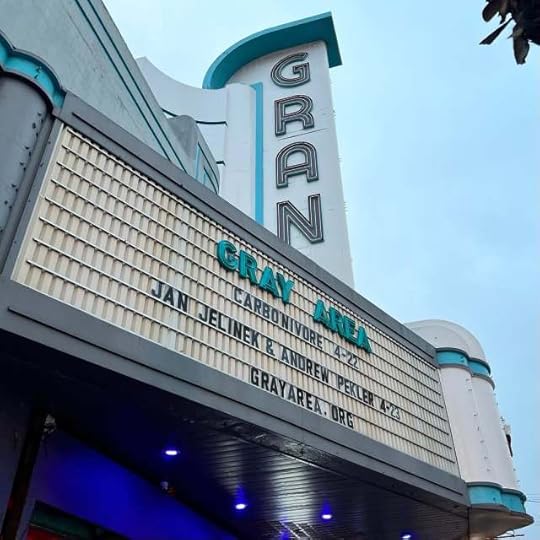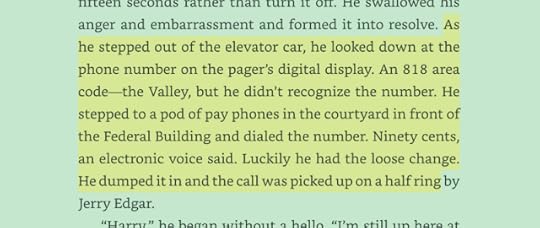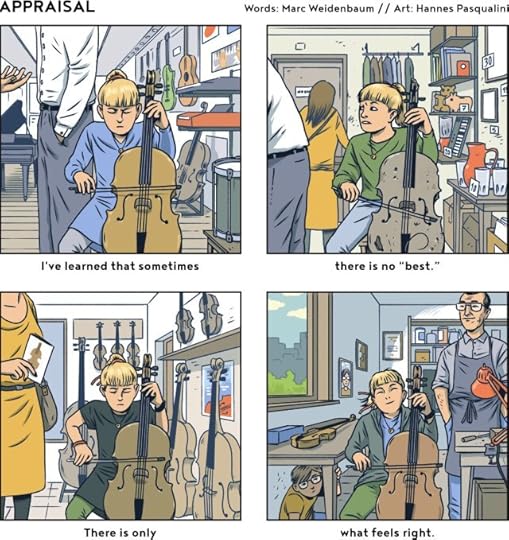Marc Weidenbaum's Blog, page 22
April 29, 2025
Livestreams After Lockdown
Pandemic-era lockdown is, for most people, a somewhat distant memory, but the normalization of livestream concerts, which rose to prominence when most people were spending most of their days and nights at home, thankfully persists. At the height of the pandemic, I reviewed a livestream for The Wire, and I remember thinking at the time how intriguing it was that the laptop on which I “attended” the concert was the same laptop on which I wrote my article (for added frisson, all the music being performed at the show involved live coding, meaning it was being played on laptops as well).
Many music venues regularly post live performances, often in real time, sometimes archived in perpetuity. Among my favorite spots that do this are listed below. If you know of other such digitally progressive brick’n’mortar spots (for electronic music, experimental music, jazz, contemporary classical, etc.) to recommend, please lemme know. Thanks to folks on Bluesky and elsewhere who fleshed this list out after I posted some initial places.
I discuss the concept of “music discovery” with people on a regular basis, and I cite venues around the world as a valuable resource. In most cases, this just means keeping an eye on the upcoming events at places like Oude Kerk (Amsterdam), the Stone (now at the New School in Manhattan — I used to sit next to Irving Stone, after whom John Zorn named the place, at Knitting Club shows on Houston Street way back in the day), and Super Deluxe (Tokyo).
Venues that actually post their live music online provide an incredible opportunity to hear what’s going on out there. Most of the below are on YouTube. For the moment, I’m emphasizing places that don’t charge for viewing.
Bird and Beckett (San Francisco)Cafe Oto (London) has its own dedicated page, not updated often, but a treat when it isCave (Akron), which streams on TwitchConstellation (Chicago)Coaxial (Los Angeles)DNA Lounge (San Francisco), and note that it has a dedicated streaming page on its websiteElastic Arts (Chicago)Emmet’s Place (Manhattan)Experimental Intermedia (Manhattan)Experimental Sound Studio (Chicago)Maple Leaf (New Orleans)Mezzrow (Manhattan)Roulette (Brooklyn)Smalls (Manhattan)There’s lots of other resources, like the email newsletters dedicated to Toronto (Soundlist) and to Sydney (emus), and the Bay Improviser website in the San Francisco area (where I live), but for the purposes of this list of resources, I’m focused on free live streaming.
April 28, 2025
Stigmatic Ambient Music
I asked Google the following, which is to say I put the question into the search box:
What is stigmatic ambient music?
Google’s “AI overview” provided an immediate response, the opening of which read as follows:
Stigmatic ambient music is a subgenre of ambient music that incorporates elements of dark ambient and industrial music, often exploring themes of pain, suffering, and psychological distress. It’s characterized by the use of dissonance, harsh textures, and a focus on creating a sense of unease or dread through sound design rather than melody.
Following that information were five “key characteristics,” plus a statement of “How it Differs from Traditional Ambient” (unclear why the noun “It” is lowercase there in what is otherwise title case), and four examples of this (supposed) genre in action. Each little statement, in the form of a paragraph, had one or more links appended to it, though not one of those links went to anything that actually mentioned “stigmatic ambient music.” One of the links went to a piece of music software named Stigmata.
At the bottom of the Google AI overview results was a caveat, the most factual thing on the page thus far:
Generative AI is experimental
I then typed the core part of the phrase again into the Google search bar, this time with quote marks around it, as follows. (Google has explained: “Put quotes around any word or phrase… and we’ll only show pages that contain those exact words or phrases.)
”stigmatic ambient music”
And I received this response:
No results found for “stigmatic ambient music”.
It’s intriguing that the original response, all 300-plus words of encyclopedia-emulating inference, didn’t mention that seemingly pertinent fact.
Here, for reference, is the original AI overview in full, minus the appended links:
Stigmatic ambient music is a subgenre of ambient music that incorporates elements of dark ambient and industrial music, often exploring themes of pain, suffering, and psychological distress. It’s characterized by the use of dissonance, harsh textures, and a focus on creating a sense of unease or dread through sound design rather than melody.
Here’s a more detailed breakdown:
Key Characteristics:
Dissonance and Harsh Textures:
Stigmatic ambient often features sounds that are intentionally unpleasant or uncomfortable, such as distorted synth sounds, noise, and harsh rhythmic elements.
Focus on Atmosphere:
The primary goal is to create a specific mood or atmosphere, rather than to present traditional melodic structures or harmonies.
Psychological Distress:
Themes of pain, suffering, and psychological distress are often explored, using sound to evoke a sense of unease, dread, or even despair.
Industrial and Dark Ambient Influences:
Stigmatic ambient draws inspiration from both dark ambient and industrial music, incorporating elements of both genres.
Sound Design over Structure:
Unlike traditional ambient music, stigmatic ambient often prioritizes the creation of specific soundscapes and textures over formal structure or melody.
How it Differs from Traditional Ambient:
While both focus on atmosphere, stigmatic ambient deviates from traditional ambient’s emphasis on relaxation and tranquility by deliberately creating discomfort and tension.
Examples:
While specific examples can vary, some artists and works known for incorporating elements of stigmatic ambient include:
FluidShell Design’s Stigmata:
This instrument is described as allowing real-time sound modification and is designed for creating dark, atmospheric soundscapes, according to bestservice.com.
Brian Eno:
Although not explicitly stigmatic, Eno’s early ambient work laid the groundwork for the genre and his sound design principles are still influential.
Dark Ambient artists:
Many dark ambient artists explore similar themes and techniques, often using industrial sounds and dissonant textures.
Industrial music:
Some industrial bands explore similar thematic territory, using harsh sounds and textures to create a sense of unease and distress.
Of course, once I post this article, at 12:45pm PDT on April 28, 2025, there will be, for the time being, one search result for “stigmatic ambient music.”
April 27, 2025
On Repeat: Beats, Live, Score
On Sundays I try to at least quickly note some of my favorite listening from the week prior — things I would later regret having not written about in more depth, so better to share here briefly than not at all.
▰ Very much enjoying the recent Barker album, Stochastic Drift (released by Smalltown Supersound on April 4), especially the heavy Selected Ambient Works Volume II vibe of the track “Positive Disintegration.” (Barker is British, and lives in Berlin.)
▰ Fantastic live set from jazz bassist Linda May Han Oh (Malaysia-born, Australia-raised), with Ambrose Akinmusire (trumpet — Oakland, California) and Pulitzer Prize winner Tyshawn Sorey (drums, New Jersey), recorded at the Keith Haring Theater, Performance Space, NY, back in January. Akinmusire is a somewhat recent favorite of mine, and I love hearing my instrumentalist favorites in supporting, or at least non-leading, roles.
▰ Dutch musician Rutger Hoedemaekers’ score for the science fiction TV series Moresnet is moody and dramatic — cinematic, for sure, but also pleasingly touched by the weird. Hoedemaekers previously worked on, among other projects, Trapped (with Jóhann Jóhannsson and Hildur Guðnadóttir) and The Last Berliner.
April 26, 2025
Scratch Pad: Covers, Gunshots, Jelinek
At the end of each week, I usually collate a lightly edited collection of recent comments I’ve made on social media, which I think of as my public scratch pad. I find knowing I’ll revisit my posts to be a positive and mellowing influence on my social media activity. I mostly hang out on Mastodon (at post.lurk.org/@disquiet), and I’m also trying out a few others. And I generally take weekends off social media.
▰ The house stereo in this cafe is playing one cover song after another, and it’s a bit like being transported to an alternate reality where different people wrote and performed all these songs. That said, I like our reality better. Or liked — perhaps I’m stuck here forever.
▰ Pro tip: something is likely wrong with either your headphones or software if the speech-to-text tool you’re using keeps transcribing everything you’re saying as “[gunshots] [gunshots] [gunshots]”
▰ “Your experience order number is …”
▰ A very good evening, April 23 (Andrew Pekler, Jan Jelinek), also featuring Chris Otchy as the opener:

▰ Dunno if this Apple case I got on eBay for my aging iPhone 13 is legit but it’s more legit than the previous iPhone case I got on eBay
▰ Hyper-local* post: the macapuno ice cream at Polly Ann in the Sunset District is extraordinary, entirely distracting me from the chocolate with which it shared a small cup
*San Francisco
▰ I’d like to play more video games, but I end up reading novels. I’d like to listen to more podcasts, but I end up listening to audiobooks.
April 25, 2025
Listening to Bosch

This segment is from early on in The Black Echo, the first in the Bosch series of detective novels by Michael Connelly. I’ve watched all of the TV adaptation, and figured I would give one of the books a read, prompted in large part by an article in the Los Angeles Times by Sue Horton about the centrality of that city (which I have a strong affection for, though I’ve never lived there) to Connelly’s books. There are 25 Bosch volumes to date. That’s a whole lot of Los Angeles, though then again, Los Angeles, nearly four million people spread out over nearly 500 square miles, is a whole lot of city.
The earliest Bosch novel is old enough that the technology here is noticeably pre-modern. In a subsequent scene in the same book, Bosch’s partner, Jerry Edgar, waits for a “machine” so he can take care of writing up the day’s reports. The “machine” is not a computer but a typewriter, of which there aren’t enough in the department to go around. When a computer does enter the picture, along with it comes a dedicated human operator, a signal to the reader of how unusual such an object was back in the late 1980s and early 1990s. The first Bosch book was published in 1992, by which time I’d had a computer — two or three, that is — for well over a decade. But the workplace, especially the city government workplace, was and remains a different setting from a home office.
What struck me about this particular section of The Black Echo is how carefully Connelly describes all the details of phone communication: the checking of the pager, the approach to the pay phones, the required coins, and perhaps most importantly, the way meaning can be construed from interactions, like here how quickly Bosch’s partner picks up the phone. This is the sort of writing that someone engaged in historical fiction might work hard at, getting all the micro-interactions, all the object names and uses, exactly right. What’s great is that Connelly did it at the time, writing about the sort of technological interfaces that can get lost as time proceeds — a lesson that those writing today, fiction and non-fiction, should keep in mind, as the technology of communication continues to change rapidly.
April 24, 2025
Disquiet Junto Project 0695: Clean After Each Use

Each Thursday in the Disquiet Junto music community, a new compositional challenge is set before the group’s members, who then have five days to record and upload a track in response to the project instructions.
Membership in the Junto is open: just join and participate. (A SoundCloud account is helpful but not required.) There’s no pressure to do every project. The Junto is weekly so that you know it’s there, every Thursday through Monday, when your time and interest align.
Tracks are added to the SoundCloud playlist for the duration of the project. Additional (non-SoundCloud) tracks also generally appear in the lllllll.co discussion thread.
Disquiet Junto Project 0695: Clean After Each Use
The Assignment: Put a piece of music through the dryer.
Step 1: Think about lint for a moment — all the stuff that’s cast off from your clothes when you send them through the dryer.
Step 2: Now consider what might be cast off from your music if you could send your music through the dryer for a cycle or two.
Step 3: Select a piece of your own music, and send it through the metaphorical dryer. What results?
Tasks Upon Completion:
Label: Include “disquiet0695” (no spaces/quotes) in the name of your track.
Upload: Post your track to a public account (SoundCloud preferred but by no means required). It’s best to focus on one track, but if you post more than one, clarify which is the “main” rendition.
Share: Post your track and a description/explanation at https://llllllll.co/t/disquiet-junto-project-0695-clean-after-each-use/
Discuss: Listen to and comment on the other tracks.
Additional Details:
Length: The length is up to you. Keep it light?
Deadline: Monday, April 28, 2024, 11:59pm (that is: just before midnight) wherever you are.
About: https://disquiet.com/junto/
Newsletter: https://juntoletter.disquiet.com/
License: It’s preferred (but not required) to set your track as downloadable and allowing for attributed remixing (i.e., an attribution Creative Commons license).
Please Include When Posting Your Track:
More on the 695th weekly Disquiet Junto project, Disquiet Junto Project 0695: Clean After Each Use — The Assignment: Put a piece of music through the dryer — at https://disquiet.com/0695/
April 23, 2025
Musikfestival Bern x Disquiet Junto

I’ll have more details in the coming weeks, but for now I’m excited to report that the Disquiet Junto is again teaming up with Musikfestival Bern for a trio of music composition prompts this year. The first will occur on May 1, the second in mid-June, and the third in mid-July. More on the festival at musikfestivalbern.ch (from which the above screenshot was taken). Thanks again to Tobias Reber for the invitation to collaborate.
April 22, 2025
Appraisal

This is the 14th comic in the ongoing series I’m doing with Hannes Pasqualini. See a full index of Frame by Frame comics at disquiet.com/fxf. More from Hannes at hannes.papernoise.net.
April 21, 2025
Categories
Deconstructionism: everything is a text
A nearby library:





